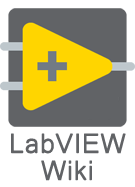LabVIEW Wiki:Manual of Style
This is the manual of style for LabVIEW Wiki. Its goal is to achieve a consistent look and feel by providing guidelines for creating, editing and maintaining pages on LabVIEW Wiki. Whenever possible, editors should strive to follow these guidelines.
If you are new to LabVIEW Wiki and all this stuff makes your head swim, start by sharing your knowledge. Other LabVIEW Wiki editors will come forward (they always do) and bring your contributions in line with the style guide.
If you have any questions or want to see it changed/amended/clarified, use the Discussion page or go to the LabVIEW Wiki Support Forum.
Page naming conventions
- See also: Help:Starting a new page and Help:Moving a page
Lowercase second and subsequent words in titles
Do not capitalize second and subsequent words unless the title is a proper noun (such as a name) or is otherwise almost always capitalized (for example: "John Wayne" and "Art Nouveau", but not "Computer And Video Games").
Prefer singular nouns
Nouns in page titles should generally be in singular form unless a noun is always used in plural form (such as scissors or trousers).
Avoid "the" and "a" or "an" at the beginning of the page name
If the definite or indefinite article would be capitalized in running text, then include it at the beginning of the page name. This would be the case for the title of a work such as a novel. Otherwise, do not include it at the beginning of the page name.
Categories
- See also: Help:Starting a new page, Help:Editing pages, and Help:Category
Every page should belong to at least one category. Leave the page uncategorized if you don't know which category to use. Uncategorized articles can be found using Special:Uncategorizedpages.
Add a "See also" section
- See also: Help:Links
If you know of other LabVIEW Wiki articles that are related to the current article, add links to them in a special section at the bottom called "See also". This section should be placed at the bottom of the article before the "External links" section. Only LabVIEW Wiki articles should be linked here.
Add an "External links" section
- See also: Help:Links
Every page should have an "External links" section. Use this section to link to external (non LabVIEW Wiki) web pages. For example, to the LabVIEW help documentation on ni.com. External links must be named. Do not just add the URL. Use a proper link description or keyword.
Images
- See also: Help:Images
- Prefer centered images.
- Images should always be framed.
- If an image is larger than 600px wide then it should be thumbnailed at 600px.
- Use captions to explain the relevance of the image to the article.
- Don't use image or figure numbers in your caption as this makes editing difficult. Inserting images will result in a large editing task for the remaining image references.
- When uploading an image, add a description during the upload process. This can be longer and more detailed than the caption. This is useful when the reader clicks on the image source looking for more information.
Other specific conventions
The following words, when used in the title or body of a page must be capitalized and written as shown below.
- LabVIEW - Do not use labview, LV, etc.
Use wikilinks
- See also: Help:Wikilink
"Build the web" is the idea of connecting relevant topics throughout an article using wikilinks since all articles in the Wiki are nodes in a hypertext system. Do not just write the article, but also consider its place in the link web. Make upward links to categories and contexts. Make sideways links to neighboring articles. Do not build category trees too deep and narrow, or too flat. Writing category directories first (top-down) will help ensure that subcategory articles get useful names.
If you are not happy with a link, improve the link or improve the linked article. Only in rare cases is it better to remove the link altogether (apart from the case of a duplicate link). Remember that a linked article does not automatically pop up, it only appears if you click on it, so it does not do any harm. If you want to give selected links more emphasis, there are better ways to do that than deleting the less important ones.
Remember that a link can also be useful when applying the "What links here" feature from the target page.
